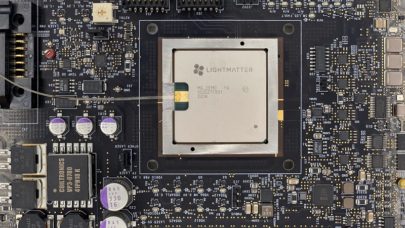HPE Slingshot Is Going Optical with Help from Ayar Labs
February 24, 2022
Technology heavyweight Hewlett Packard Enterprise and optical IO startup Ayar Labs have embarked on a strategic collaboration to advance silicon photonics in the datacenter and integrate optical IO into a future generation of HPE’s Slingshot interconnect. Optical-based interconnects are essential to overcoming the bandwidth, latency, power and distance... Read more…

Photonics Processor Aimed at AI Inference
August 18, 2020
Silicon photonics is exhibiting greater innovation as requirements grow to enable faster, lower-power chip interconnects for traditionally power-hungry applicat Read more…

NIST Photonics Chip Breaks New Ground and Models Neural Net
August 7, 2018
Researchers at the National Institute of Standards and Technology (NIST) have made a silicon chip that distributes optical signals precisely across a miniature Read more…

GlobalFoundries, Ayar Labs Team Up to Commercialize Optical I/O
December 4, 2017
GlobalFoundries (GF) and Ayar Labs, a startup focused on using light, instead of electricity, to transfer data between chips, today announced they've entered in Read more…

Mellanox Readies First 200 Gb/s Silicon Photonics Devices
March 22, 2016
At the Optical Fiber Conference taking place from March 22-24 in Anaheim, Calif., Mellanox is announcing an "important milestone" on the road to High Data Rate (HDR) 200Gb/s InfiniBand and Ethernet networks. At the trade show, the company is demonstrating 50 Gb/s silicon photonics optical modulators and detectors, which will comprise key elements of 200 Gb/s and 400 Gb/s LinkX cables and transceivers. Read more…
IBM Advances Silicon Photonics, Quantum Computing
May 14, 2015
Engineers at IBM have developed a fully integrated wavelength multiplexed silicon photonics chip, which the company says will soon enable manufacturing of 100 G Read more…

Breakthrough for Photonic-Electronic Microchips
October 8, 2013
Silicon photonics is in the spotlight again, being pitched by researchers at the University of Colorado Boulder, the Massachusetts Institute of Technology and M Read more…

Intel Lights Up Silicon Photonics at Open Compute Summit
January 17, 2013
Technology will enable decoupling of compute and storage in server racks. Read more…

- Click Here for More Headlines

Whitepaper
Transforming Industrial and Automotive Manufacturing
In this era, expansion in digital infrastructure capacity is inevitable. Parallel to this, climate change consciousness is also rising, making sustainability a mandatory part of the organization’s functioning. As computing workloads such as AI and HPC continue to surge, so does the energy consumption, posing environmental woes. IT departments within organizations have a crucial role in combating this challenge. They can significantly drive sustainable practices by influencing newer technologies and process adoption that aid in mitigating the effects of climate change.
While buying more sustainable IT solutions is an option, partnering with IT solutions providers, such and Lenovo and Intel, who are committed to sustainability and aiding customers in executing sustainability strategies is likely to be more impactful.
Learn how Lenovo and Intel, through their partnership, are strongly positioned to address this need with their innovations driving energy efficiency and environmental stewardship.
Download Now
Sponsored by Lenovo
Whitepaper
How Direct Liquid Cooling Improves Data Center Energy Efficiency
Data centers are experiencing increasing power consumption, space constraints and cooling demands due to the unprecedented computing power required by today’s chips and servers. HVAC cooling systems consume approximately 40% of a data center’s electricity. These systems traditionally use air conditioning, air handling and fans to cool the data center facility and IT equipment, ultimately resulting in high energy consumption and high carbon emissions. Data centers are moving to direct liquid cooled (DLC) systems to improve cooling efficiency thus lowering their PUE, operating expenses (OPEX) and carbon footprint.
This paper describes how CoolIT Systems (CoolIT) meets the need for improved energy efficiency in data centers and includes case studies that show how CoolIT’s DLC solutions improve energy efficiency, increase rack density, lower OPEX, and enable sustainability programs. CoolIT is the global market and innovation leader in scalable DLC solutions for the world’s most demanding computing environments. CoolIT’s end-to-end solutions meet the rising demand in cooling and the rising demand for energy efficiency.
Download Now
Sponsored by CoolIT
Advanced Scale Career Development & Workforce Enhancement Center
Featured Advanced Scale Jobs:
HPCwire Resource Library
HPCwire Product Showcase
© 2024 HPCwire. All Rights Reserved. A Tabor Communications Publication
HPCwire is a registered trademark of Tabor Communications, Inc. Use of this site is governed by our Terms of Use and Privacy Policy.
Reproduction in whole or in part in any form or medium without express written permission of Tabor Communications, Inc. is prohibited.
























